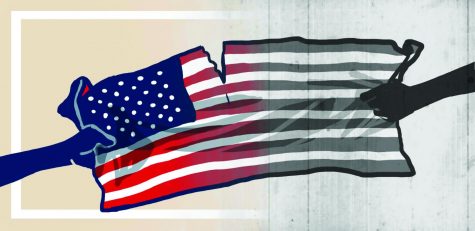5 decades and more divided
1968 wasn’t just another year. Turmoil defined 1968 with assassinations, riots and movements for underrepresented minority groups. Tension still holds 50 years later within America. Inequality among groups may never be fully resolved, and protests against inequality continue today. From Americans’ consumption of news to political polarization, 2018 shows the American people have become increasingly divided in opinion.
January 26, 2018
Racial tension. War. Gender inequality. Protests. A nontraditional election and a choice that was unconventional. Is this today? No, it was 50 years ago in 1968.
With riots at the Democratic National Convention in Chicago, the assassinations of Martin Luther King Jr. and Robert F. Kennedy, 1968 was filled with turmoil. An unpopular Vietnam War forced President Lyndon B. Johnson to forgo re-election, resulting in the election of Richard M. Nixon, who had lost just eight years earlier.
Fifty years after one of the nation’s most turbulent years, progress on many of the same issues may be hard to notice. Americans in 2018 are sharply divided on issues from politics to equal rights.

Political polarization continues in 2018
Just as 2018 saw political polarization between Democrats and Republicans, 1968 was the culmination of intense divisions between the two major parties, whites and African-Americans, and the North and South. According to Duke University Professor William Chafe, an expert on African-American history and the civil rights movement, the divisions in 1968 led to a breakup of social movements.
Professor Chafe said, “It’s the most fragmented the country had been since the Civil War.”
During the 1968 Summer Olympics in Mexico City, two black athletes, Tommie Smith and John Carlos, each raised a black-gloved fist as a Black Power salute. Nearly five decades later, NFL players protested racial inequality by kneeling, linking arms as a team or sitting on the sidelines during the national anthem.
According to Rutgers University Professor Charles Payne, an expert on urban education and African-American history, recent years have seen similar kinds of protests on racial inequality as 1968.
“1968 was a year of intense polarization,” Professor Payne said. “Of hard hats and hippies. A good deal of racial tension.”
Contemporary protest groups learned from ‘60s
King led the Southern Christian Leadership Conference, which was led by black, male ministers throughout the civil rights movement, but modern-day movements like Occupy Wall Street and Black Lives Matter both did not develop a top-down leadership structure. According to Professor Payne, modern-day protest groups learned from 1960s movements.
“Groups like Black Lives Matter seem to me to be more sophisticated than some of the earlier protests just because they have the advantages of the hindsight they’ve learned from the past,” Professor Payne said. “On questions like leadership, the Occupy Movement and Black Lives Matter were both very self-conscious of not allowing the creation of top-down, charismatic, usually male leadership. That’s their reaction to what they thought went wrong in the 1960s and how they can sustain themselves.”
1968 was a year of intense polarization. Of hard hats and hippies. A good deal of racial tension
— Charles Payne
By 2018, Black Lives Matter and protests against racial inequality have brought policy changes to policing in the form of some departments mandating body cameras and the formation of oversight committees. Professor Payne said the mass action of Black Power movements in the late 1960s and protests led by Black Lives Matter have had an impact on the pattern of police brutality.
“Despite the fact that some people don’t like the movement, that they’re angry about it,” Professor Payne said. “It has had some impact — the fact that more police departments require body cameras, although I’m not sure how much difference they’re going to make. It’s still a policy response to a grievance.”
Racial resentment still present in America
However, policy is separate from individual attitudes. The same racism King dealt with in 1968 still plagues Americans today, according Dr. Bart Schultz, Senior Lecturer and Director of the Civic Knowledge Project at the University of Chicago, who said that much of the backlash against Barack Obama’s presidency is similar to the racism King faced throughout his life.
“We have witnessed a really dreadful reaction to Obama’s presidency, an extraordinarily violent and bizarre attempt to discredit him,” Dr. Schultz said, “and it’s very reminiscent of the type of ugly racism that King confronted.”A clear difference between 1968 and 2018 is America’s consumption of news. In 1968, most American families received the same news as other Americans. With the rise of online media and niche news outlets, Americans in 2018 can stay read a variety of sources.
“One clear difference is that there is no analog in 1968 to cable television/Fox News,” Professor Payne said. “That is, that everyone watched Walter Cronkite back then, so that even people who were on different sides of many issues, tended to have the same information base. Where as now, if you read The Washington Post, you get one set of ‘facts.’ And, if you read Breitbart News, you get another set of ‘facts.’”
Nation survived 1968 — can it survive 2018?
While 1968 may have felt like the world was unraveling, looking at the year in hindsight, Professor Payne said that the consequences were not as dire as many people expected at the time. There are lessons to be learned 50 years later.
“The assassination of Robert Kennedy coming so soon after the assassination of Martin Luther King, in the context that we were beginning to lose a war for the first time, in the context of changing gender roles,” Professor Payne said. “All of that gave many people the sense that society was falling apart. It wasn’t as bad as it looked at the time.”